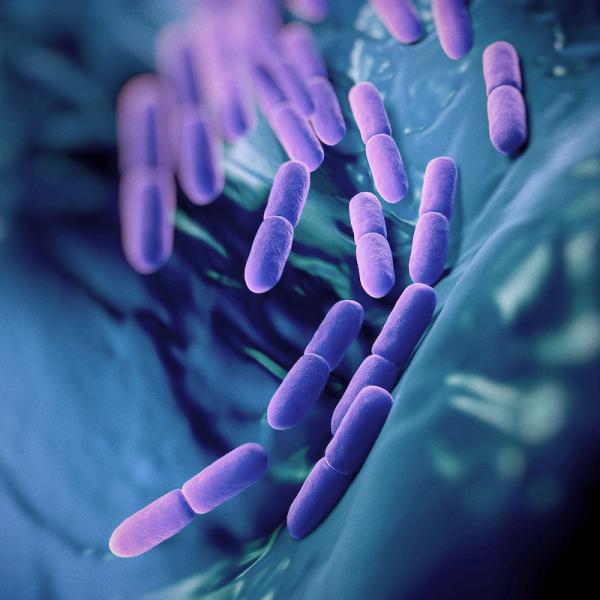We present a mathematical model and computer simulations for the control of a pathogenic biofilm by a probiotic biofilm. This is a substantial extension of a previous model of control of a pathogenic biofilm by microbial control agents that are suspended in the aqueous bulk phase (H. Khassehkhan and H.J. Eberl, Comp. Math. Meth. Med, 9(1) (2008), pp. 47-67). The mathematical model is a system of double-degenerate diffusion-reaction equations for the microbial biomass fractions probiotics, pathogens and inert bacteria, coupled with convection-diffusion-reaction equations for two growth controlling substrates, protonated lactic acids and hydrogen ions (pH). The latter are produced by the bacteria and become detrimental at high concentrations. In simulation studies, we find that the site of attachment of probiotics in the flow channel is crucial for success and efficacy of the probiotic control mechanism.
By: Dr Hassan Khassehkhan

Context and Motivation
Bacterial biofilms are communities of microorganisms that attach to surfaces and secrete protective matrices called extracellular polymeric substances (EPS). These biofilms are highly resistant to environmental stresses, including antibiotics, making them significant in medical and industrial contexts. Traditional antibiotic treatments often fail due to the slow penetration of chemicals and metabolic adaptations of bacteria in the biofilm core. Hence, alternative approaches such as using probiotics have gained interest.
Probiotics are beneficial bacteria that can inhibit pathogens through competition for resources or by altering local environmental conditions-specifically by producing substances like lactic acid that lower the pH and create a hostile environment for pathogens. This research aims to mathematically model such interactions and simulate the effectiveness of probiotic biofilms as a biological control mechanism.
Model Description
The authors develop a coupled system of nonlinear partial differential equations to represent:
The growth and distribution of three types of biomass: probiotics, pathogens, and inert (dead) biomass.
The concentrations of two key chemical substrates: protonated lactic acid and hydrogen ions (which affect pH).
Key assumptions and features of the model include:
Bacterial growth is governed by local concentrations of lactic acid and pH. Growth occurs when lactic acid levels are low and pH is high; decay happens under the opposite conditions.
The diffusion of biomass and chemicals is density-dependent, meaning that transport rates vary with local biomass concentrations.
Hydrodynamic flow in the channel is modeled to account for the removal or supply of substrates, simulating a realistic flow environment.
The model is simulated in two spatial dimensions (2D), representing a thin, rectangular flow channel.
To solve the system numerically, a non-standard finite difference scheme is used, which ensures the preservation of important mathematical properties like positivity, boundedness, and sharp interfaces between regions of growth and decay.
Simulation and Results
Through a series of computational experiments, the researchers investigate the dynamics of mixed-culture biofilm formation and the competition between probiotics and pathogens. Key findings include:
Influence of Location: The spatial positioning of probiotic inoculation plays a crucial role. Colonies located near the inflow area of the channel, where nutrient conditions are more favorable, grow more robustly and can effectively suppress pathogen growth downstream.
Biofilm Dynamics: Initially, both types of bacteria grow. As lactic acid accumulates and pH drops, pathogenic bacteria begin to die and convert into inert biomass, especially in the downstream areas. Probiotic colonies, being more tolerant to acidic conditions, survive longer.
Colony Interactions: In some simulations, probiotic and pathogenic colonies merge to form mixed-culture biofilms. Over time, the probiotic component dominates due to its higher tolerance, gradually replacing the pathogenic biomass.
Effectiveness of Control: In simulations where probiotics were randomly inoculated, results varied-some showed partial pathogen control, while others did not. However, when probiotics were deliberately placed near the inflow region, control was consistent and more effective.
Conclusion
The study concludes that the probiotic control of pathogenic biofilms via environmental modification (acidification and pH lowering) is a promising strategy. However, its success depends heavily on spatial factors such as the initial location of probiotic colonies.
This mathematical framework allows for the exploration of biofilm behavior and control strategies in a way that complements laboratory experiments. Although current models are primarily qualitative due to limited empirical data, they can help identify key factors influencing biofilm dynamics and suggest hypotheses for future experimental validation.
 | A mixed-culture model of a probiotic biofilm control system |

